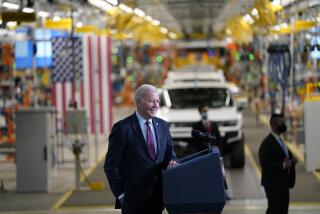White House gives EPA emissions plan a strategic PR push
With fresh memories of the disastrous Obamacare rollout, the White House launched a campaign-style push Monday to promote its plan to slash carbon emissions 30% by the year 2030.
The aggressive effort — which included rebutting Republican denunciations, managing Democratic divisions and seeking to minimize industry backlash — signaled a greater awareness by the White House of the stakes for President Obama’s legacy and his party’s chances in the upcoming midterm election.
Key aides began plotting both the policy and the public relations effort long before this week. The decision to use 2005 as the baseline for the 30% reduction was itself a concession to industry groups worried that the targets might be unrealistic. Because emissions nationwide have already dropped more than 15% since 2005, using that year as the baseline makes the targets easier for states and power plants to hit.
The public messaging placed a special emphasis on ways the plan would give states flexibility to meet the targets on their own terms. Administration officials argued that the plan is sensitive to the special needs in some heavily coal-reliant states.
The president and his allies framed the issue as one of public health and safety, placing new emphasis on asthma and lung cancer as well as making traditional arguments about rising sea levels and increasingly violent storms. The Environmental Protection Agency estimated its rule would prevent up to 6,660 premature deaths and 150,000 asthma attacks in children by 2030.
“In America we do not have to choose between the health of our economy and the health of our kids,” Obama said.
Obama played a supporting role Monday — notable given how the president’s name is so linked to his healthcare overhaul. He opted for an afternoon conference call with advocates, during which he appealed to parents and grandparents worried about “the health of our kids and the health of our planet.”
The formal unveiling came earlier, with unusually blunt public remarks by EPA Administrator Gina McCarthy. She criticized opponents of the rule, calling them special interests who “cried wolf to protect their own agenda” during previous battles over environmental rules.
“Climate change is calling our number. And right on cue, those same critics once again will flaunt manufactured facts and scare tactics,” she said. “Our climate crisis is a global problem, and it demands a global solution, and there is no Hail Mary play we can call on to reverse its effects.”
By then, opponents had already begun their attacks, led by Republicans long opposed to what they call anti-business regulatory schemes.
Mitch McConnell of Kentucky, the Senate’s Republican leader who is seeking reelection this year, called the proposal “a dagger in the heart of the American middle class, and to representative Democracy itself.” House Speaker John A. Boehner (R-Ohio) said more simply that the plan “is nuts.”
Republican campaigns were quick to use the announcement to begin new attacks, portraying the rule as an energy tax and “job killer,” the same arguments used against the Affordable Care Act.
“Throughout his presidency, Barack Obama has adopted a ‘my way or the highway’ approach, and that explains why he’s shoving these EPA regulations down our throat,” said Reince Priebus, Republican National Committee chairman.
Republicans are hoping to seize control of the Senate this fall, and the EPA rule could provide them with campaign ammunition to use against vulnerable Democrats, particularly in coal-producing states.
On Sunday, the administration invited Democratic lawmakers to join what one participant described as a part pep talk, part strategy session with McCarthy and John Podesta, a former chief of staff to President Clinton who joined the White House this winter to help guide such initiatives. The president was an unannounced participant.
Aware of the potential peril the proposal would represent for some Democrats, administration officials also had individual calls over the weekend with lawmakers from fossil-fuel-dependent states to walk them through the proposal. Those consultations came with a polite request from the White House, according to a staffer briefed on one conversation: Criticize the plan if you must, but narrow the critique to focus on the economic impact on your state, rather than the overall efficacy of the plan.
Democratic candidates running from outside Washington were left to tackle the issue as they saw fit. Alison Lundergan Grimes, the Democratic nominee who will face McConnell this fall, highlighted her advocacy on behalf of the coal industry and released an ad that will appear in newspapers serving the state’s coal regions, declaring “President Obama and Washington don’t get it. Alison Grimes does.”
“I will stand up to President Obama, Gina McCarthy and anyone else who tries to undermine our coal jobs,” said Natalie Tennant, Democratic nominee for Senate in West Virginia. “Washington bureaucrats need to understand, these are not numbers on a balance sheet. They are real people with families to feed.”
Others candidly acknowledged that the rule will make things harder for them this fall. “I know that attack [is] coming regardless of what I do, whether I speak out or whether I’m silent, whether I try to work with the administration as I have in the past or whether I lash out and burn all bridges that are left,” said Rep. Nick J. Rahall II, a veteran West Virginia Democrat who is a top target of the GOP.
Industry also is divided over the feasibility of the rule. Jeannice Hall, a spokeswoman for the Southern Co., which owns a vast fleet of coal plants in the Southeast, said in a statement that the EPA rule was ill-considered: “EPA’s proposed emission guidelines appear to be based on reduction measures that extend well beyond Clean Air Act requirements and infringe upon states’ authority to determine the best approach for their own generating sources.”
Some expressed relief that the rules were not more stringent. The Edison Electric Institute, the industry trade association, said the EPA had crafted a workable approach. “While the 2030 reduction target is ambitious, it appears that utilities may be allowed to take advantage of some of their early actions,” said Tom Kuhn, the association’s president.
Because carbon dioxide emissions from power plants have already fallen more than 15% since 2005, the actual reduction the power sector would have to make by 2030 from present-day levels would be more like 15% to 17%, rather than 30%, industry analysts said.
Christi Parsons in the Washington bureau contributed to this report.
More to Read
Start your day right
Sign up for Essential California for news, features and recommendations from the L.A. Times and beyond in your inbox six days a week.
You may occasionally receive promotional content from the Los Angeles Times.








